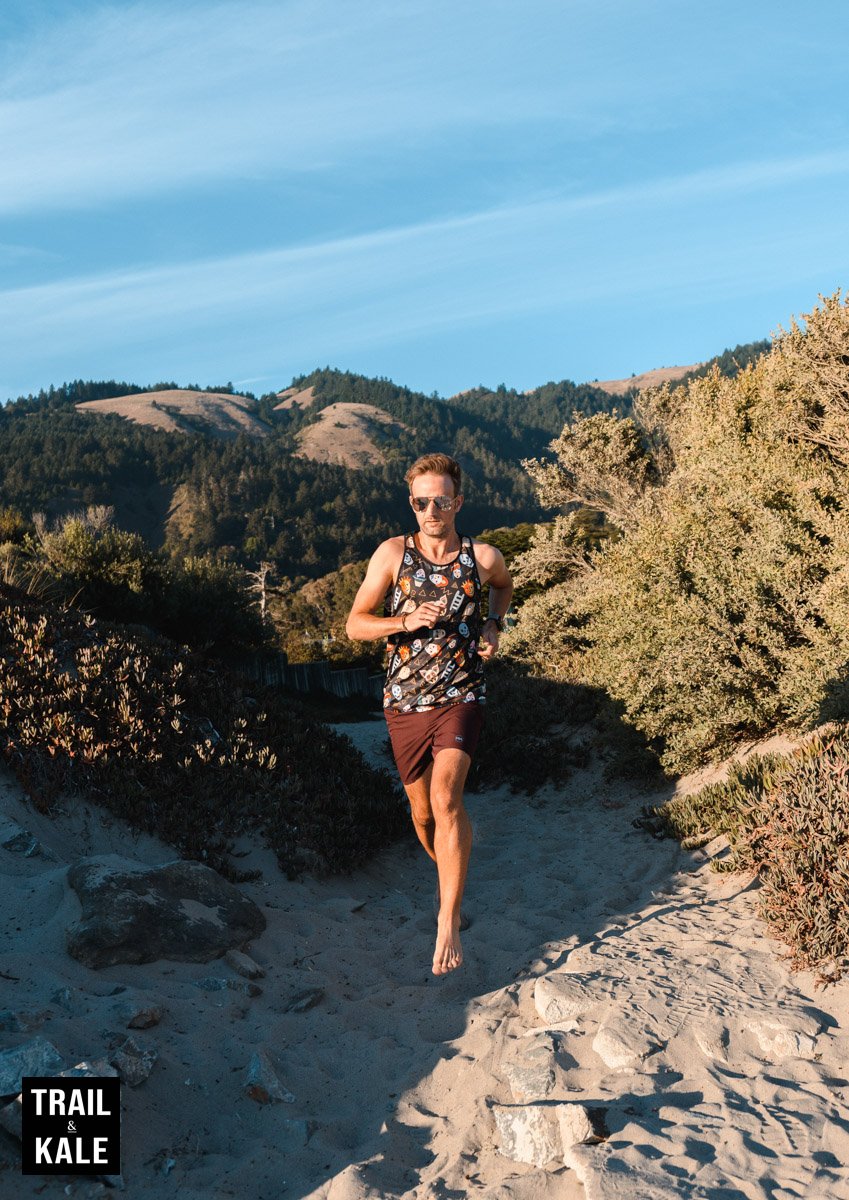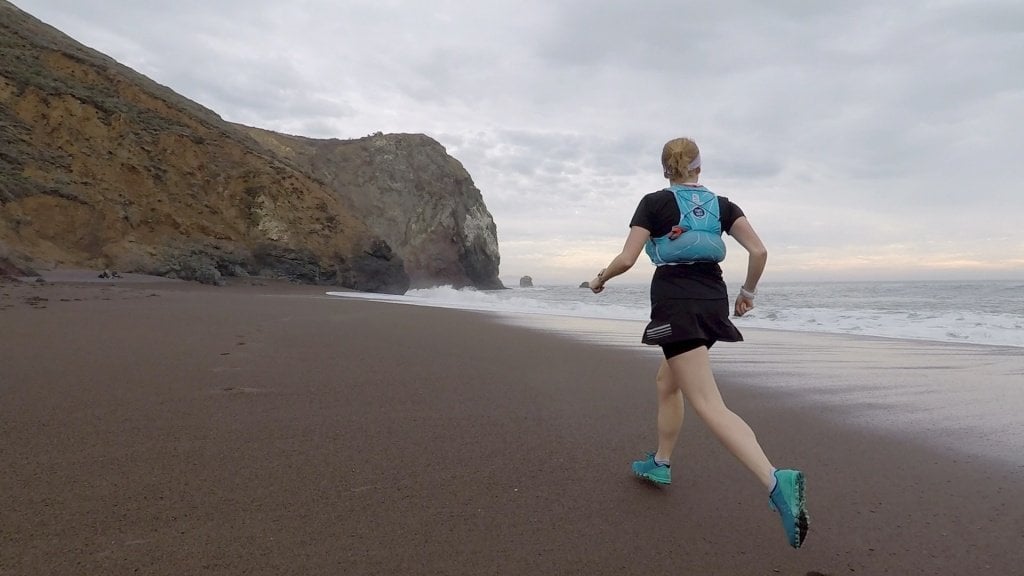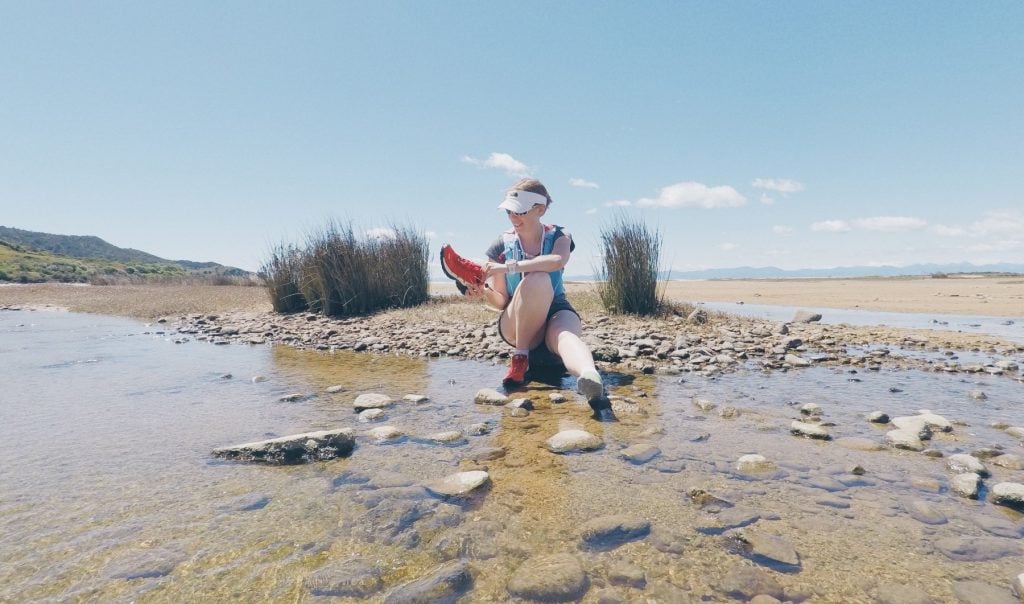Running on the beach is not only a great way to enjoy the scenic views of the coastline, but it also provides a unique workout experience that can benefit both your body and mind.
The softer, sandy surface creates increased resistance, engaging muscles that may not be as activated during road or treadmill running.
Additionally, running in soft sand can reduce the impact on your joints compared to running on pavement, and on certain beaches it may be safe to run barefoot, which encourages you to adapt your running form to a more natural style of running.
I’m personally a big fan of running on wet sand, which tends to be hard-packed but still offers a challenging workout, all the while being surrounded by nature and breathing in that fresh ocean air!
In this ultimate guide, I explain the benefits of beach running and share my tips to get the most out of your run, including sand running technique, what shoes to wear (and when it may be ok to run on sand barefoot), how to get sand out of your shoes, and important safety considerations.

Benefits of running on the beach
Compared to running on pavement, taking the opportunity to head out for a run on sand offers a number of benefits.
Increased resistance and muscle activation
Running on sand is definitely harder than running on the road – let’s just get that out there!
It requires more effort and energy than road running on a solid surface like concrete, as the sand gives way as you land and push off, rather than providing a hard surface for you to rebound from.
This results in increased muscle activation, particularly in the calves, hamstrings, and glutes, which can help to build strength and endurance.
If you don’t have good access to run on sand, you could also consider trail running, which also offers softer, uneven surfaces which pose more of a challenge and greater muscle activation potential than a smooth sidewalk or paved path.
Reduced impact on joints
Whether you’re actually barefoot running (without any shoes at all) on the beach, or wearing a pair of running shoes, the softer sandy surface encourages a more natural running form, and shorter strides, as well as providing a softer landing surface, which can reduce the impact on your joints and associated muscle damage.
This means it can be a great alternative to pavements if you find those hard surfaces uncomfortable to run on, as it can alleviate stress on your joints and help to prevent common running overuse injuries associated with the impact of landing on hard pavement.
It goes without saying, however, that if you have an injury or any pain or concerns in this area, you should consult a medical professional before heading out for some sand running.
On the same topic of improving running form, studies suggest that running on the beach can help if you suffer from over-pronation in your feet.
The study found that foot posture index can be improved after a program of barefoot running on the beach, at a pre-defined speed (⁓3.3 m/s) over level stable ground on the sand.

Scenic and refreshing environment
Running on the beach provides a scenic and refreshing environment that can help to reduce stress and improve mental health.
Similar to other places in nature where you can head out for a trail run, the sound of the waves, the smell of the ocean, and the fresh air can all contribute to a positive workout experience.
An increased balance and stability challenge
Running on uneven and shifting sand requires more balance and stability than running on a flat surface. This is even more the case with dry sand, which tends to be softer and more uneven than wet, packed sand.
Training on the sand can therefore help to improve proprioception and strengthen stabilizing muscles, leading to better overall balance and coordination.
You should, however, expect your running speed to be slower than running on harder surfaces, so this is not the time to go chasing a PR!
Increased calorie burn
Due to the increased resistance and effort required to run on sand, beach running can result in a higher calorie burn than running on solid surfaces.
This can help to support weight loss goals and improve overall fitness levels.
Running shoes vs. barefoot running
Depending on when and where you plan to run, it may be necessary to wear shoes.
Selecting the best shoes for beach running
Types of sandy surfaces where wearing shoes are a good idea include pebble beaches, beaches with debris such as broken coral, tree branches or trash that may wash up on the shore – the latter being a sad reality in many places.
In these situations, most running shoes will be fine for running on the beach, although my personal preference is to select an older pair (meaning – not your current ‘A’ pair!).
Choosing an older pair of shoes means that if you get your feet wet or there’s any residual sand left in them afterwards, you don’t discover those pesky sand granules when they start rubbing between your toes halfway through your next long half marathon training run!
In terms of traction and sole type, I’ve found that although trail running shoes have the advantage over regular running shoes, it doesn’t make that much difference if you’re just running on sand.
However, for beaches with rocky or pebble sections, then yes, stick with the trail shoes and be mindful of wet, slick rocks where grip can be an issue!
Whichever running shoes you opt for, remember to get the sand out of your shoes as soon as possible after your run, and possibly during your run if you find they get full up!
To get all the sand out, loosen the laces remove the insole (read ‘how to dry shoes‘ to learn how to do that correctly) and ensure they’re dry before shaking them and banging them against a firm surface outdoors.
It can also help to use a firm brush (actually, an old toothbrush works great for this) to get down into the toe area to sweep out any sneaky grains of sand that are left behind.
Running barefoot on sand
There’s nothing more liberating than prancing over that soft sand with nothing on your feet!!
Running barefoot on sand is a great way to build up improved balance and foot strength, as well as a more natural gait. Barefoot running is, after all, how our ancestors got around, and some native tribes still do.
As with anywhere, if you choose to run without footwear then you are at increased risk of injury from sharp objects or hot sand, lack of protection and support.
It’s also worth noting that, as with wearing minimalist barefoot-style running shoes with no midsole cushioning or heel-to-toe drop, there is the potential for overuse injuries from overloading the muscles and tendons of the foot and ankle if you’re not used to running without shoes on.
This makes it important to gradually transition to barefoot running on the beach by starting with short durations and distances, and pay attention to any discomfort or pain before it develops.
It also helps to start on wet, firm sand, which can be a little easier to run on than soft, dry loose sand, while you get used to running on sandy surfaces.
By the way, if you’d like to learn more about barefoot running, then pick up a copy of one of (in my opinion) the best books about running ever written: Born to Run, and thank me later once you’ve read it 🙂

Softer sand vs. hard packed wet sand
Running on dry, softer sand is generally more difficult than running on wet, hard-packed sand.
When running on soft sand, your feet sink in deeper, making it more challenging to push off and maintain a steady pace. This requires more energy and can lead to fatigue and a higher heart rate.
On the other hand, while running on hard-packed sand provides a more stable surface and requires less energy to run on, it can still be challenging if the sand is uneven or sloped, as this can affect your balance and gait.
The best time to hit the beach for running on wet sand is when the tide is on its way out.
The retreating tide leaves hardening sand and you should be able to run on it without getting your feet wet.
Beach running tips for running on the sand
Adjust your stride and pace
If you’ve tried it before, you’ll have already quickly found that running on sand requires a shorter stride and a higher cadence than running on solid surfaces.
Having shorter strides at a higher running cadence helps to maintain balance and avoid sinking into the sand.
Focus on landing lightly on your feet and lifting your feet quickly, and remember to use your arms! Using your arms help to counterbalance and propel you forward while running on sand. Swing them naturally and keep them close to your body.
Mix up your terrain
Running on different types of sand, including wet and dry sand, can provide a varied workout and engage different muscles.
Warm-up exercises
Just like any other workout, warming up before beach running is important to prevent injuries and improve performance.
Focus on dynamic stretches that target the muscles you’ll be using, such as lunges, squats, and leg swings.
Protect yourself from weather exposure
Running on the beach can be physically demanding and exposes you to the sun and wind, so it’s important to stay hydrated and protected.
Drink plenty of water before and after your run, and consider bringing a water bottle with you. I personally prefer a running hydration pack to carry water, my phone and any other essentials such as snacks and layers, handsfree.
Additionally, apply a waterproof sunscreen with at least SPF 30 to protect your skin from the sun’s harmful rays.
I never head out for a run on the beach (or pretty much anywhere… even if it’s not sunny) without a good technical running hat and polarizing running sunglasses.
Wearing these can make a huge difference to your running comfort levels and enjoyment so I highly recommend taking them with you for every run!
On days when the weather is less pleasant, a windproof or waterproof running jacket may be important, as well as other apparel suitable for cold weather runs, as appropriate.
Take breaks as needed
Running on sand can be more physically demanding than running on solid surfaces, so it’s important to listen to your body and take breaks as needed.
Remember to stay hydrated and fuel your body with nutritious foods before and after your run. If you may be out for a while, consider taking a couple of energy gels with you in case you need an extra boost at some point along the way.
Be sensible
Ok this last beach running tip falls within the real of always using common sense, but I’ll say it anyway…
Be aware of your surroundings and know your limits! Make sure the weather and tide conditions are appropriate for you to be spending time on the beach, and make safety your number one priority.
Avoid running on the beach when it’s crowded, during storms, exceptionally high tides or where any beach hazards such as landslides or large waves are a risk.
If you choose to run at low tide, make sure you’re familiar with the tidal ranges so you don’t get stuck in a potentially dangerous situation if the tide comes back in – this happens to people more than you’d think!
In summary
Running on the beach is a great way to enjoy a challenging workout in a natural environment.
Whether you live near the coast or a lakefront beach, inland sand dunes, or perhaps you’re just considering being active at the beach on vacation, I highly encourage you to give beach running a go!


![The Best Trail Running Shoes [2024] The Best Trail Running Shoes [2024]](https://www.trailandkale.com/wp-content/uploads/2024/02/best-trail-running-shoes-Trail-and-Kale-Recommends-2024-110x75.webp)



